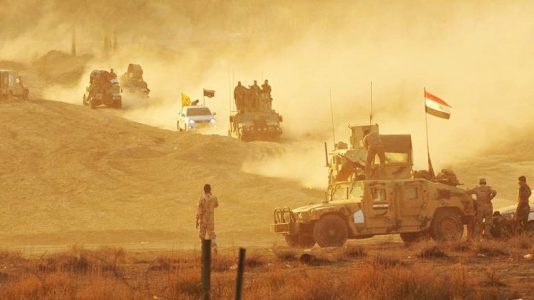
Iraqi forces launched military operations to pursue the remnants of the Islamic State terrorist group
Iraqi forces launched two separate military operations on Monday to pursue the remnants of the so-called Islamic State in central parts of the country as well as in long stretches of desert wasteland near the Syrian border. The offensives come as the terrorist group has renewed its insurgency across various parts of Iraq.
One of the operations took place in the westernmost parts of the largely-barren Rutba district of western Anbar province, Iraqi state media INA reported Monday. The Popular Mobilization Forces (PMF)—an umbrella grouping of mostly Iran-backed Shia militias known in Arabic as the Hashd al-Shaabi—also participated.
The operation came after an incident on Sunday in which fighters thought to be from the Islamic State but described in military statements only as a “terrorist group” launched an armed assault on a village in Rutba’s al-Walid subdistrict, kidnapping one resident. A security unit deployed to the area and clashed with the fleeing fighters, killing one. The exchange also led to the death of one civilian and injuries to three others.
On Tuesday, the military communications center called the Security Media Cell (SMC) reported that forces had captured two suspected terrorists in an ambush in an area between the Walid and Tarbil subdistricts, west of Rutba. The town of Tarbil is situated on the Jordanian border with a reportedly high Palestinian population.
Anbar province also borders Syria, from where large numbers of Islamic State members have infiltrated Iraqi territory after the group lost all of its Syrian territorial claims in March 2019 at the hands of the Kurdish-led Syrian Democratic Forces (SDF) backed by Coalition airpower.
The second operation, also on Monday, took place in the Mutaibija area of Salahuddin province’s Samarra district, according to an SMC statement. The army and other security forces began a “massive military operation within the Mutaibija region to hunt Da’esh [ISIS] remnants and enhance security and stability in them.”
Immediately bordering Diyala province—another area where the terrorist group has been notably active recently—, Mutaibija has been the site of repeated Iraqi operations since the Islamic State’s territorial collapse in Iraq in late 2017.
The sprawling domain’s rugged terrain, covered with dense vegetation, has made it a favored hiding spot for insurgents to regroup and plan attacks on nearby localities and security outposts. Multiple rural areas of Iraq with similarly rough topography have long been exploited by the terrorist organization’s sleeper cells to as launchpads for future attacks.
In a separate statement later Monday, the SMC also announced the arrest of a suspected Islamic State “executions committee official” in an ambush on the road leading to Salahuddin’s southernmost Dujail district, a Shia-majority section of the predominately Sunni province.
As the terrorist organization stepped up its attacks over the past several weeks, Iraqi, French, Australian, British, and American aircraft carried out air operations against militant hideouts across different parts of Iraq in April, anti-ISIS Coalition spokesman Col. Myles B. Caggins III said in a tweet on Sunday.
The recent efforts come amid increased numbers of insurgent-style attacks by the group, emboldened as a series of crises that Iraq finds itself embroiled in. From the new coronavirus outbreak that has crippled governments worldwide to the ongoing power-struggle in the national capital over the composition of a cabinet, much-needed attention appeared to have been diverted away from areas where Islamic State operatives have always been most active.
Between the first of the year and April 22, members of the terrorist group have killed 170 civilians and security personnel in attacks across the country, according to a recent military statement. In that time period, forces were reported to have carried out 1,060 security operations, killing 135 Islamic State fighters, destroying 279 hideouts and tunnels, as well as seizing and disposing of large numbers of explosives, rockets, and suicide vests.
Early Tuesday, a member of the terrorist group detonated his suicide vest while attempting to penetrate the intelligence headquarters of Kirkuk province, one of the most prominent areas disputed between the Kurdistan Regional Government (KRG) and the federal Iraqi government. Six people were reportedly wounded.
Top Kurdistan Region officials and Peshmerga commanders have issued repeated warnings to both the Iraqi government and the international community that the Islamic State remains active and capable of reasserting itself to continue its campaign of violence, especially in disputed territories.
“All the root causes that led to the rise of ISIS, and the collaboration of the people with ISIS,” as Kurdistan Region Prime Minister explained in a February interview with France 24, “still exist.”
Despite years of attempts by the Iraqi government to stop their growth, terrorist groups continue to find new recruits from Sunni-majority areas of Iraq in part, perhaps, because of the treatment Sunnis received at the hands of Shia-led Baghdad, continuing a vicious cycle of violence 17 years after the fall of former Iraqi dictator Saddam Hussein, whose government favored Sunnis and repressed all others.
This can be demonstrated in the case of two individuals who stand trial on terrorism-related charges in the US and Germany. Both are from Anbar’s Falluja; one was in his early teen years when the other is alleged to have killed Iraqi police officers as part of the Al Qaeda in Iraq group.
The living conditions of Sunnis under a Shia-led government—periodically worsened depending on the ruler—may just have facilitated the Islamic State’s recruitment of now-27-year-old Taha al-J, fighting at the whims of a Saddam-era senior military officer said to have established the terrorist group in 2012.
Source: Kurdistan 24





